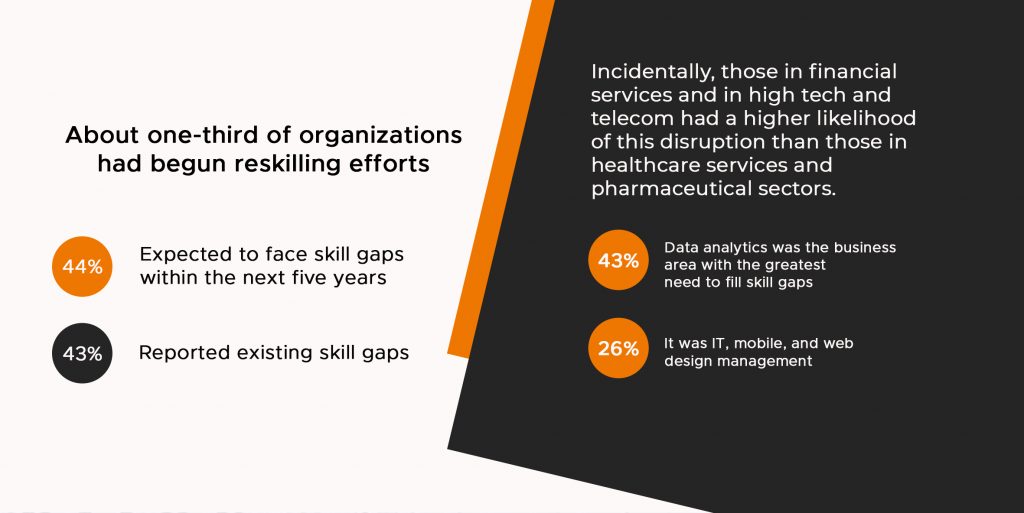In an age where every business is a software business, it’s hard to maintain competitiveness and impact in the market when one is struggling with inadequate software talent. With the emergence of AI, data science, machine learning, analytics, neural networks, etc., the demand for new-age software skills has become even more pronounced. As IT companies vie for the same pie of software development talent, some skill areas become more acute than ever.
Gaps in software development skills, then, become quite ruthless and hard to fix. According to a McKinsey global survey on future workforce needs, nearly nine in ten executives and managers shared that they either face skill gaps already or expect gaps to develop within the next five years. But just one-third of companies were prepared to cope with the workforce disruptions resulting from technology and market trends. Most organizations were hiring employees in an attempt to prepare for potential skill gaps, and some were making efforts to build skills in their workforces.

New insights from LinkedIn show a steady progression towards a skills-based labor market, spurred on by the pandemic and digital transformation reshaping all aspects of work.

According to The 8th edition of the Dice Tech Job Report, software engineers and developers remain in solid demand. But those who’ve mastered the skills essential for building and maintaining tech stacks and databases, such as SQL, automation, and software development principles, are more likely to grab the jobs they are looking for. What gets accentuated, then, is the need to always keep one’s skills up to date; recruiters and hiring managers can (and should) take steps to ensure that all job candidates are well-versed in the latest and greatest tech. They should also consider training programs to up-skill (and retain) current employees, as studies have shown a strong desire for continuing training and education of technologists.
Skill gaps in Software Development – how to spot, fix and fill them?
It is essential for an organization today to be proactive and nimble-footed in addressing these skill gaps. They cannot be put on the back burner anymore. Every business function, in some way or another, needs fast applications and impactful customer experiences through technology. So one has to be quick, smart, aggressive, and prudent in identifying and filling these software skill gaps before it’s too late. The key to doing this is an intelligent mix of screening, skill assessment, training, and development. And that’s where one would need to leverage a strategic and cohesive approach to skilling and training.
Time for integrated training
Consider how Otomeyt’s integrated talent development platform is helping enterprises do precisely that– solving their skill gaps through solid solutions that straddle all areas well – from screening and skill assessment to training and development.
The salient word here is ‘integrated’ because when every area and skill aspect tie in well together, the result is deep and compelling. This approach helps enterprises to drive a sustainable and sharp skill strategy – making them future-proof against new trends and needs.Otomeyt’s wide berth of capabilities helps by arming enterprises with an integrated training platform with proven learning methodologies. This is done through a significant swathe of features and strengths:
- Up-skilling with well-designed training with weekly capsules
- Bootcamp training for campus hires
- Expert skilling for existing resources
- Reskilling initiatives for new hires
- Product-led training and evaluation
- Virtual learning environments (VLE)
- Customization of content and training curriculum
- Real-time capstone projects
- Use of Cloud and analytics
In short, an end-to-end solution that leaves nothing to chance.
Approaching software development skill gaps head-on
It’s a crucial decision for any organization. And those who start early and are intelligent reap their advantages. However, according to the McKinsey survey, while most respondents at organizations with current or planned reskilling programs were confident in their organization’s abilities to choose employees to train and skills to teach, most felt they lacked the capabilities for designing other aspects of the programs. For example, fewer than half felt that their companies have strong capabilities in curriculum design, and only one-quarter said their organizations designed the programs’ incentives well. As these struggles overwhelm HR leaders and CEOs, nearly seven in ten respondents reported that reskilling says the program’s business impact has been greater than or equal to the investment in them. And

Conclusion
It’s critical that if you are also sniffing any software development skill gaps in your enterprise- you should start arming yourself with the core ingredients to nip the bud before it gets out of control.
Be proactive. Be measured. Be holistic. Be smart. And be software-ready.
- Embracing Agility and Inclusion: The Power of a Skills-First Approach in Talent Management - August 14, 2023
- How to Reduce Time to Proficiency and Measure Onboarding Effectiveness - August 10, 2023
- Unleashing the Power of AI: Transforming Learning and Development in Your Organization - August 1, 2023

